Living the Caddyshack dream
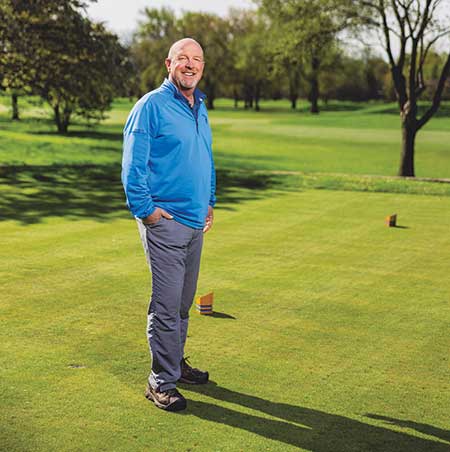
Dave Schlagetter (Photo: Tim Klein)
Danny Noonan, thanks to that scholarship, went on to graduate from Northwestern University and was a successful stockbroker for more than 30 years.
Maggie O’Hooligan, like many of her immigrant coworkers, was treated like family as a dedicated lifelong employee of Bushwood. Carl Spackler went on the run after blowing up an entire fairway and was quickly replaced by a clean-cut young buck with the latest skill and know-how.
It’s been 40 years since Caddyshack opened in theaters across the nation. The film is one of the most frequently quoted movies not just on golf courses, but frequently quoted, period.
It stars the most famous greenkeeper ever on film, Bill Murray’s Carl Spackler.
In honor of the landmark number, Golfdom spoke with people who inspired the movie and who appeared in the movie, as well as superintendents who worked on the grounds that both inspired — and literally was — Bushwood Country Club.
Our story starts off with a boy in a suburb of Chicago just trying to “be the ball.”
From shag boy to Evans Scholar Ed Murray, the oldest of the six Murray brothers, was at church when divine intervention — in the form of a caddymaster — came into his life.
“They were serving mass one day, and there was a strange man in the sacristy,” recalls Ed Murray. “Nowadays, you’d call the police. He said he was caddymaster at Indian Hill Club, looking to hire some caddies, and if we came to the club after school, he would teach us how to caddy, and we could make a lot of money.”
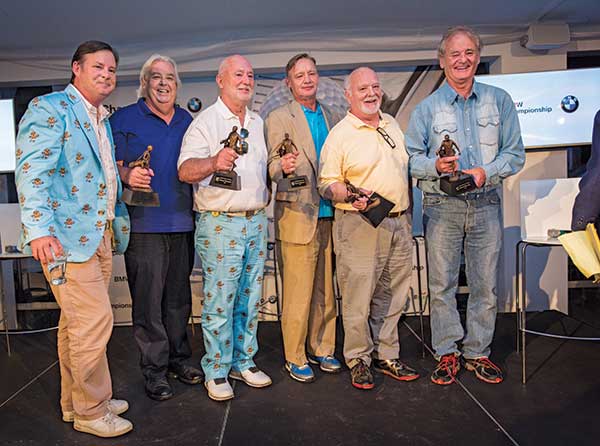
It’s quite an honor to be in the hall of fame,” says Ed Murray of he and his brothers’ induction into the Caddy Hall of Fame in 2015. “The next year was Bones McKay, Mickelson’s caddie. I introduced myself and said I made it to the hall before you! He retired a year or two later.” From left: Joel Murray, Andy Murray, Ed Murray, John Murray, Brian Doyle-Murray and Bill Murray. (Photo: Charles Cheney/Western Golf Association)
Murray, 10 years old, showed up with his friends and learned on the job he was too small to carry a golf bag. By the end of a loop, members would take the bag from him out of sheer pity. He switched to a shag boy, chasing down practice balls on the 11th fairway and then became the exclusive shag boy for Sam Bernardi, head pro. He was making 60 cents per half-hour, but the door it opened with Bernardi, a Chicago legend, was much more lucrative. Eventually, Bernardi started giving Murray lessons. As Murray got older, he was hired to caddie for Bernardi, first for local Chicago tournaments, then the Western Open, then the 1961 PGA Championship at Olympia Fields (Ill.) CC.
Bernardi told Murray about the Evans Scholars Foundation and encouraged him to apply. Murray says he was an average student at best. One day, Murray came home and his mother read him a letter, trembling. She told her son he had won a full scholarship from the Evans Scholars Foundation. Then one more surprise: The scholarship was to attend prestigious Northwestern University.
“I said, ‘Holy shit, I got problems!’ I was so sure I wouldn’t get in to Northwestern, I didn’t apply,” Murray says. “Luckily, we had a couple members … Foster McGaw, they named the basketball stadium after him, and Fritz Souder, he was president of Western Golf Association. They said we have to get this kid in. (Northwestern) said, his SATs aren’t high enough.
They said it doesn’t matter, he already has a scholarship. I got in.”
Murray winning the Evans scholarship would lead him to a career as a successful stockbroker, but it also inspired his younger brother, Brian Doyle-Murray, who played caddymaster Lou Loomis in the film, with the nugget of an idea: a blue collar kid working at a stuffy country club, hoping to change his life for the better.
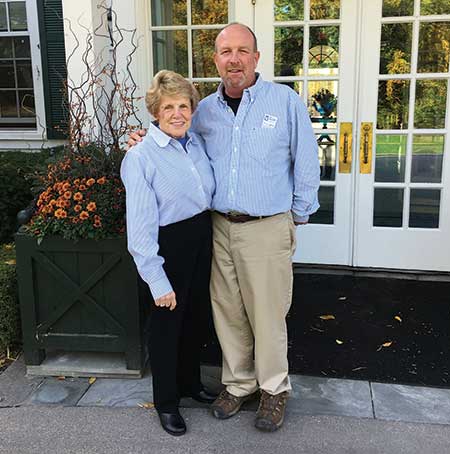
Schlagetter says of Kerrigan, now retired, “I had coffee with her every day. I miss her tremendously.” (Photo: Indian Hill Club)
Danny Noonan was born, based on Ed Murray’s wild ride to Northwestern. Ed Murray, now age 76, says most of the characters in Caddyshack were based on people they caddied for or met at the club. He softly laughs and then adds one correction to his character: “I never touched that girl.”
A family club
Indian Hill Club, located in the Chicago suburb of Winnetka, Ill., has an appropriate slogan: A family tradition since 1914.
“It’s a family club in the truest sense. We do a lot for women and kids,” says David Schlagetter, longtime superintendent at Indian Hill. “It’s not a championship course by any means. We have a strong tennis program, strong swimming and golf is kind of … family golf.”
Though the club indirectly spawned Caddyshack, its preferred talking point is how the club has a tradition of hiring young and keeping their employees for the long haul.
“That’s how Indian Hill rolls. They hope you will be here for a long time so they hire young, and they’ve done it in all areas,” Schlagetter says. “The golf pro here before me was here for 37 years. The chef when I started here was here for 45 years. We have guys that are busboys that have been here for 25 years. It’s a culture of longevity that the club has embraced. They tell us that we’re part of the family … and they walk the walk, too. They treat us that way.”
Case in point, his “work mom,” Nellie Kerrigan. She arrived from Ireland when she was only 19 years old. Retired now, she worked for the club for 55 years. And she’ll tell you — she was not the inspiration for Maggie O’Hooligan, Danny Noonan’s Irish sweetheart. There were a lot of young Irish girls working at the club at the time, including her older sister and her twin sister.
“I came from Ireland when I was very young. I was only 19, and I came with my twin,” Kerrigan recalls. “My sister was here ahead of me, and I never left.”
It was the people of Indian Hill — that family atmosphere — that kept her there all those years. She started out as a waitress and finished as clubhouse manager, a mother to all of Indian Hill’s members.
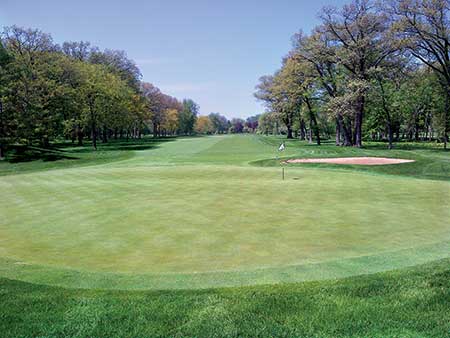
Schlagetter has worked 27 years at Indian Hill. “From the beginning, he was a perfect fit — great person, smart, fun and humble,” says Dick Wagley, PGA, retired head pro. (Photo: Indian Hill Club)
“I love the people. The members were amazing. They became my second family. I saw four generations of members; it was unbelievable,” she says. “I grew up with these people. I was only 19, and I’m not 19 now, darlin’. But I feel like I’m 19.”
She remembers the reaction in 1980 when Caddyshack hit theaters. Some members were offended by the movie, she says, because in many cases, the movie used the real names of the members it was mocking.
She also recalls a cocky young Bill Murray walking toward her in the Indian Hill parking lot.
“He was young and he said, ‘You’re going to read about me one day in Hollywood,’” she says. “And I said to myself, ‘Oh my gosh, what does this kid know at 13, or 11,’ whatever he was? But he knew then what he wanted.”
The origin of Carl Spackler
Some have argued that the lowbrow humor Bill Murray portrayed, as assistant superintendent Carl Spackler and his roughshod methods of greenkeeping, was harmful to the image of superintendents. According to the book Caddyshack: The Making of a Hollywood Cinderella Story, author Chris Nashawaty writes, “across the board, (film critics) regarded Bill Murray’s deranged, camouflage-clad assistant greenkeeper, Carl Spackler, as unsubtle, submental and perverted.”
So, Nellie might not have been Maggie (Ed disagrees), and Danny and Maggie never were romantic (Ed and Nellie agree), but who inspired Carl Spackler?
Ed Murray responds with a “who?” The Spackler character is small potatoes to him. He’ll talk about the real Ty Webb, the real Lou Loomis. He says Sam Rivera was based on Sam Bernardi. He knew those people. But Spackler?
“Billy’s character? In the original script, I used to have it, I wish I had it now because I would have Xeroxed a million copies and given them away at charity auctions,” Murray says. “In the original script, there are two or three pages that say, ‘Bill will ad-lib. Chevy and Bill will ad-lib.’ That’s all it said. So those scenes you saw in the shed, they made that up as they were doing it. Nobody knew what they were going to do. The scenes with the guns and the gophers and stuff, it came from Billy’s head.”
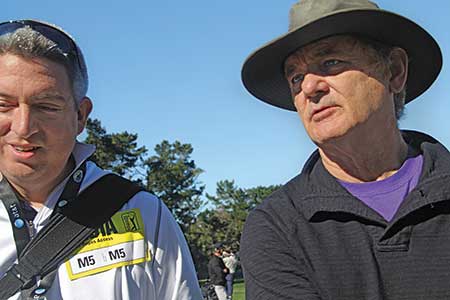
At the 2012 AT&T Pro-Am at Pebble Beach, Golfdom Editor-in-Chief Seth Jones (left) asked Bill Murray about his inspiration for Carl Spackler. His answer was even more mystical, and indecipherable, than what the Dalai Lama — flowing robes and all — said to Spackler that day in the Himalayas. (Photo: Sean Ipford)
So, there was no basis in reality for Carl Spackler. It was just Bill Murray and Chevy Chase riffing. But it was a riff that would become famous and often imitated (“chinch bugs, manganese … lot of people don’t even know what that is …” “a pond would be good for you …”), at golf courses across the country, for the next four decades and counting.
Spackler’s wheels
Bob Harper arrived in Miami in 1979 via Dodge City, Kan. A scratch golfer, he was there determined to do two things: play golf for Florida International University (FIU) and learn the trade of being a golf course superintendent.
To be on the golf team at FIU meant that Harper was going to see some nice golf courses for a kid from the Old West. One course stood out on his junior season schedule: Rolling Hills CC in Davie, Fla. The reason? It was the same course where Caddyshack was filmed.
“It was exciting to get to see it,” Harper recalls. “I graduated in 1981, and I’ll be darned if I didn’t get a job to work there on the crew, September 1981.”
Harper has made a career in Florida, spending six years at Rolling Hills (now known as Grande Oaks CC) then Grand Palms in Pembroke Pines for 12 years, followed by 16 years at Emerald Hills in Hollywood and now Lago Mar CC in Plantation for four years. It was probably meant to be, since the moment he used Spackler’s actual pitchfork to do his best Bill Murray impersonation.
“The old red barn, the old ranch house … (Rolling Hills) was a thoroughbred horse ranch from the 1940s, which later became a golf course,” Harper says. “The old white house where (Maggie) lives? That was the ranch manager’s house, which then became the superintendent’s office. And the props? Our tools, the pitchfork, were all taken from our barn.”
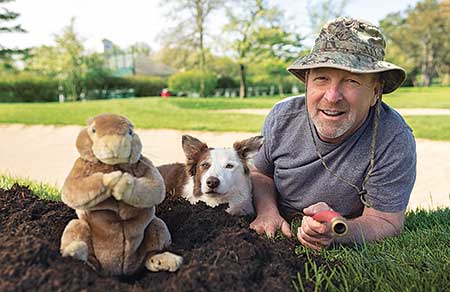
“Schlaggs,” with his dog McKenzie, has plenty of Caddyshack stories. “The caddymaster, Lou? That’s a real guy.” (Photo: Tim Klein)
Harper is especially proud of his wheels back then. It was the same ride that enabled Spackler to cause so much devastation at Rolling Hills that a pilot called in a downed airplane because of the fireball he saw near the Fort Lauderdale Airport. It was a one-seat Cushman Commando, three-on-the-tree, with an 18-hp air-cooled V-twin engine. They even put headers on it. On the back was a 100-gallon Smithco Sprayhawk with a fiberglass tank.
“It was basically awesome,” Harper recalls. “It was probably the fastest — definitely the funnest — mode of transportation. We used to race the Cushmans around because they had cart paths all around and it was very hilly.”
Don Smith, president of Smithco, remembers the thrill of seeing the company’s easily recognizable sprayer on the big screen during the climax of the movie.
“We were the first to introduce fiberglass. The competition used polyethylene or steel. Most sprayers were square; ours was round,” Smith says. “Compared to what was in the movie, a lot of advances have been made in sprayers over the years.”
Harper says that’s not all that’s changed over the years. The composition of the golf maintenance crew has also made a diversion from the 1980s, he says.
“To be on a crew back in the ’80s was really different,” Harper says. “It was almost fraternal, like a frat house. Mostly young kids, boys and girls. We had at least four or five girls on the crew all the time. A few local guys. Real casual, jean shorts and T-shirts. I had a real kinship with that place. The people, the tools … we were kind of living that Caddyshack dream every day.”
The modern day Sandy McFiddish Cushman, Smithco and Milorganite all can say that Spackler was a customer, as they’re all visible in the movie. Too bad for us that when Ty plays through Carl’s house, Spackler was studying a turf textbook, and not a back issue of Golfdom.
Harper says Spackler’s apartment in the movie was the oil room of the barn at Rolling Hills. Schlagetter says there was a ramshackle house at Indian Hill where the assistant superintendent once lived. It was next to the 12th hole, and it once was part of a sanitarium. Maybe that explains some of Carl’s behavior.
Since it’s Schlagetter’s course that spawned Spackler, when people ask him if he’s the modern-day Carl Spackler, he points out that he’s actually the modern-day Sandy McFiddish, the Scotsman head superintendent who slaps Spackler back to reality with his cap. That character was based on Joe McMoran, the longtime golf pro at Indian Hill.
“I’m lucky that Carl Spackler was the assistant superintendent, so I lean towards Mr. McFiddish,” Schlagetter says. “If you’re going to be a good superintendent, you have to be Mr. McFiddish. I’ve never met anyone who didn’t like the movie. Looking back, I think it’s done way more good than bad for us.”
Schlagetter has been better than good at Indian Hill for 27 years now. He gets emotional when he talks about how much he misses Nellie and Dick Wagley, PGA, retired pro. That’s just the culture there.
“From the beginning this guy was a perfect fit,” Wagley says. “Great person, smart, great experiences at great clubs, terrific leader of staff and members, humble and fun.”
“All the stories I hear about golf in the old days and working around the golf clubs? They’re all fun,” Schlagetter says. “There’s a joke around every party, isn’t there? And now everything seems so serious.”
Don’t nobody worry ’bout me Ed Murray had two jobs at a very early age: He was a caddy and an usher. He says both jobs taught him how to behave around adults, “a lesson in growing up.”
“We got chewed out a few times, but most of the time, it’s pretty good people,” Murray says. “You don’t see too many assholes on the golf course. It’s mostly good people.”
Ed Murray apologizes. First for his language, then for his voice. At times it shrinks to a whisper. He’s in poor health, he says. But he says it with such insouciance that it sounds OK. This is Danny Noonan, after all. Queue the Caddyshack theme song by Kenny Loggins: I’m alright; Don’t nobody worry ‘bout me.
He says Michael O’Keefe was great playing Danny Noonan. He had a beautiful golf swing. They played four or five times together the week that Murray was on the set of Caddyshack.
“Harold Ramis was the director, and it was the fourth day, and I hadn’t really done anything. He said, ‘This has to change, Ed hasn’t even been in the movie yet,’” Murray recalls. “There’s a scene where a lady gets hit in the head with a club. I’m standing there holding a beer, I have orange plaid pants on and I have dark hair. I have no hair now. That was my close-up.”
The Evans scholarship was one thing, but did he ever expect the worldwide fame Caddyshack — and his brothers — would achieve?
“Did I expect anything like that to happen? No. No way!” Murray says. “We just hoped no one would get arrested, especially before they were done shooting the film.”
Were they successful in that?
“I wasn’t arrested, but I had a good time,” he says. “Everybody had a good time.”
Goodwill at Indian Hill
Indian Hill Club has a unique history with caddies but also with good causes
“(Indian Hill) has a wonderful caddie history right from the beginning. Chick Evans, a great player of the 1910s and ’20s, was a founding member of the club,” says Dick Wagley, PGA, retired head pro of Indian Hill. “He was a wonderful influence, in the game of golf as well as building the club.”
Evans was the first amateur to win both the U.S. Amateur and the U.S. Open in the same year (1916.) But a series of lessons he filmed jeopardized his amateur status and directly resulted in the creation of the Evans Scholars Foundation.
“He was paid by a sponsor to do those and was in jeopardy of losing his amateur status … they gave him an opportunity to donate the money,” Wagley explains. “Through some of the members at the club, he was able to establish the Chick Evans Scholars Foundation. The rest is history: Now thousands of caddies have gone to college on that scholarship.”
Overseen by the Western Golf Association, more than 11,000 caddies have graduated as Evans Scholars since 1930. Not as famous as the Evans Scholars Foundation but vitally important to many superintendents around the country is the Wee One Foundation. Named after Wayne Otto, CGCS at Ozaukee CC in Mequon, Wis., the foundation financially supports golf course management professionals and their dependents who incur overwhelming medical expenses. Otto passed away in 2004 from pancreatic cancer.
The Chicagoland superintendents and Schlagetter, a board member, have been a driving force for the Wee One Foundation. The organization has donated more than $1.5 million to golf maintenance families in 23 states.
“Superintendents always support each other, whether it’s helping your neighbor with a challenging turf condition or helping an assistant move up the ranks in his or her career,” Schlagetter says. “I’m proud of my accomplishments in the industry, but none more than my involvement in Wee One. It’s a special feeling to help out someone who, through no fault of their own, really needs that support.”
Caddyshack videos
Be sure to click over to Golfdom.com for additional video content on Caddyshack’s 40th anniversary. In these two videos sponsored by Carl Spackler’s preferred brand of sprayer, Smithco, we talk to Indian Hill Club Superintendent Dave Schlagetter about his favorite story from the days the Murray brothers were caddies at the course. And in our other video, we ask superintendents from around the country to share with us their opinion of the movie and what it means to them. Find the videos here.










Michael “Ray” O’Keefe’s younger brother became president of Winged Foot GC